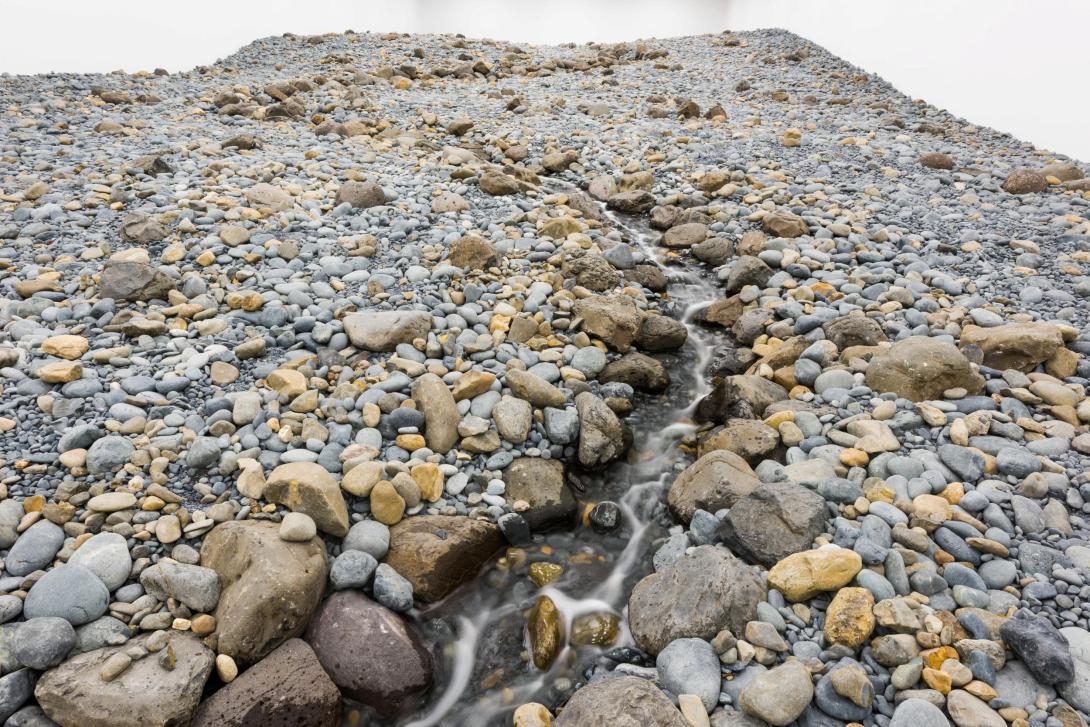Olafur Eliasson
‘Water: Cycles’
Olafur Eliasson’s Riverbed 2014 reminds us that water is precious.
Within the gallery, a small stream weaves through a landscape of water-rounded stones. This interior-environment is disconcertingly out of place. It looks natural, but also feels threatening, as if a catastrophic landslide may have just occurred. Without vegetation, birds or other markers of time and place, it is unclear whether we are standing in a near-empty riverbed, or the first upwelling of a new water source; in a place where life began, or a post-human landscape.
Like many of Eliasson’s artworks, Riverbed is inspired by the rugged beauty of Iceland. While the artist was born in Denmark, his parents are both originally from Iceland and he visited his father there regularly throughout his childhood. Riverbed is particular to Eliasson but also feels universal — a source landscape for us all.

Olafur Eliasson / Denmark/Iceland b.1967 / Riverbed 2014 installed at GOMA for ‘Water’, December 2019 / Water, rock (volcanic stones [blue basalt, basalt, lava], other stones, gravel, sand), wood, steel, plastic sheeting, hose, pumps / Purchased 2021. The Josephine Ulrick and Win Schubert Charitable Trust Collection: The Josephine Ulrick and Win Schubert Charitable Trust, Queensland Art Gallery | Gallery of Modern Art / © Riverbed, Olafur Eliasson / Photograph: N Harth, QAGOMA

Olafur Eliasson / Denmark/Iceland b.1967 / Riverbed 2014 installed at GOMA for ‘Water’, December 2019 / Water, rock (volcanic stones [blue basalt, basalt, lava], other stones, gravel, sand), wood, steel, plastic sheeting, hose, pumps / Purchased 2021. The Josephine Ulrick and Win Schubert Charitable Trust Collection: The Josephine Ulrick and Win Schubert Charitable Trust, Queensland Art Gallery | Gallery of Modern Art / © Riverbed, Olafur Eliasson / Photograph: N Harth, QAGOMA
In Iceland, as once-majestic glaciers melt they leave behind a bed of tumbled rock very like this. Immediately outside the gallery the Brisbane River flows, rising and falling with the tides. Locals will recall the floods of 2011: it is hard to imagine this wide river reduced to a fragile stream, but we need not travel far to observe the effects of drought.
In Riverbed, everything we experience is carefully planned. Under the cool grey light, Eliasson seeks to take us into a deeper reality, amplifying our interaction with the world — our awareness of nature, the flow of time, and the choices we make.
We are all welcome to find our own way through Riverbed: we might follow the suggestion of a path, or find a quiet place to sit, touch the stones and feel the water pass through our fingers.
![© Riverbed, Olafur Eliasson Artwork Riverbed this artwork made of Water, rock (volcanic stones [blue basalt, basalt, lava], other stones, gravel, sand), wood, steel, plastic sheeting, hose, pumps, created in 2014-01-01](/index.php/system/files/styles/large/private/object-images/GOMA_Water_installationview_20191204_nharth_053.jpg?itok=23Pmu_Fu)
Riverbed 2014
- ELIASSON, Olafur - Creator
